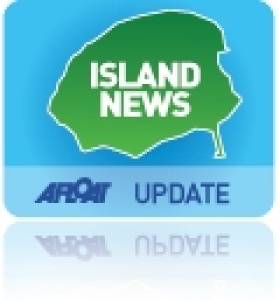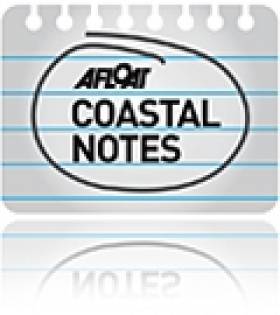Displaying items by tag: Dalkey Island Ferry
#DalkeyIslandFerry – The Dalkey Island passenger ferry boat service from Coliemore Harbour, Co. Dublin, was finally launched into service and coincidentally on the opening of the 5th Dalkey Book Festival last Thursday, writes Jehan Ashmore.
There had been no ferry service for the last three years which had been a concern of the local community who have campaigned for its restoration since the issue of 'health and safety' was raised by Dun Laoghaire Rathdown County Council on the state of Coliemore Harbour and also those on the island.
Now that the commercial passenger-ferry boat which is licensed to take 5 persons, locals and visitors can look forward to taking the 4 minute hop across Dalkey Sound.
The service is operated by Ken Cunningham, whose family for many generations have been closely involved with the harbour and also of the local East coast skiff rowing club.
During last weekend the scene at Coliemore Harbour was under a 'blocking' high weather system with blue seas and equally skies. Tourists lined the plaza overlooking the harbour and also admiring the view was a festival guest, author Salman Rushdie, of Satanic Verses fame who was there for an interview and photocall.
Against this scenic publicity backdrop the seascape also provided the setting for a local artist's group and where a former wife of Rushdie, Padma Lakshmi took a keen interest with the painting students.
As previously reported on Afloat.ie, a new slipway and quayside structure was completed on Dalkey Island and was officially launched earlier this month by An Cathaoirleach, of Dun Laoghaire-Rathdown County Council.
The opening of the upgraded island harbour facility costing €350,000 was a turning point of the PART 8 Programme in addition to works amounting to €63,500 also carried out at Coliemore Harbour, where issues concerning boating access and safety were also met. Though there were some delays to these works before the ferry eventually could start and that of a permit issued from DLRCC.
A campaign led by the Coliemore Harbour Action Committee pressed local councillors and that of DLRCC to reinstate that the 'traditional' ferry boat would remain running from the harbour as fears had been expressed of an alternative replacement service from Dun Loaghaire Harbour.
The Dalkey Island slipway upgrade incorporates a widened channel and dredging creating easier and safer access for berthing and a navigation marker post is sited at the end of the slipway.
To accommodate the tidal range, at the approach of the new structure is the 'stepped'-slipway section which runs into an upper quayside featuring a ladder and life-ring pole.
From here new steps lead to the existing footpath to the Martello Tower, the main man-made feature on the island which is designated a public park.
The island on the doorstep to Dublin and its tourism potential and the role of public engagement forms one of the main topics of the Dalkey Islands Conservation Plan: 2014-2024 which was launched by DLRCC earlier this month.
The other principle topics of the plan to recognise and manage island issues are: history & archaeology, natural heritage, geological heritage, archaeological and built heritage.
Consultants to Carry Out Survey of Coliemore Harbour
#COLIEMORE HARBOUR FERRY – Asides the controversial issue of the granting for an exploratory oil well drill license off Dalkey, local residents group have also stepped up a campaign since the summer to restore the island ferry which has not been operating in recent years, reports Jehan Ashmore.
As previously reported on Afloat.ie, Dun Laoghaire-Rathdown County Council's recent unveiling of a consultant's report of the proposed PART 8 Scheme to upgrade Dalkey Island harbour, also sees the same consultants appointed to carry out a separate survey of Coliemore Harbour, the traditional mainland embarkation point of the ferry run by generations of local families.
The consultants Malachy Walsh & Partners are to carry out a structural survey on the condition of the small stone cut harbour completed in 1868, which aswell as a tourist attraction is an amenity throughout the summer for anglers, divers and kayakers alike.
DLRCC which owns the harbour, have deemed the piers unsafe and claim concerns over public safety issues for those accessing the harbour when commercial boats were in operation. It is expected that DLRCC are to receive the conclusions of the report though not until February or March, this is to enable the consultants to monitor winter weather impacts on the harbour.
The council have claimed that repair costs could be prohibitive, possibly running into millions and it is understood that such expenditure were not factored into council's Capital Programme 2012-2016. As previously alluded, the PART 8 scheme exclusively deals with Dalkey Island alone where there also plans to restore the Martello Tower and Gun Battery, though not St. Begnet's Church which is the responsibility of the OPW.
The ferry restoration group, has also called for the short five-minute ferry ride to the 22-acre island be reinstated by a licensed operator. The licensing is under the remit of the Marine Survey Office at the Department of Transport and a future ferry service would require an open tendering process.
It has been feared by locals that the demise of a boat service arising from Coliemore's closure to ferry services, could lead to a temporary or longer term service running from Dun Laoghaire.
As previously reported on Afloat.ie a new cruiseliner tender dock facility was installed earlier this year as part of the Dun Laoghaire Harbour Company masterplan, where the facility would also be used for boat tours of Dublin Bay and to Dalkey Island.
It has been suggested that should such a service run, that a RIB based craft would be likely used on the longer exposed crossing to the island and taking up to 25 minutes. The consequences of an enhanced ferry operation and its potential impacts on the island were discussed as part of last month's inaugural Dalkey Island Forum.

























































